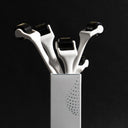Are you noticing bald spots from hair extensions?
In this article, we delve into why hair extensions can sometimes lead to hair loss, and how to prevent and treat these unwanted bald spots effectively.
Table of content
Hair extension and bald spots
Hair extensions can cause bald spots due to traction alopecia. This occurs from constant pulling on the hair, resulting in thinning areas and bald spots where the tension is greatest.
To minimize the risk of developing bald spots from hair extensions, it's crucial to choose the right type of extension and ensure they are applied correctly.
Opting for lighter, less constrictive extensions and having them professionally fitted can significantly reduce the strain on your hair follicles.
It's also important to regularly adjust the extensions to prevent excessive pulling on any one area of the scalp.
Additionally, giving your hair regular breaks from extensions allows the scalp to recover and strengthens the hair roots.
Incorporating scalp massages and using nourishing hair care products can further support the health of your hair and reduce the chances of traction alopecia.
These steps not only promote healthier hair but also enhance the longevity of your natural locks.
As your leading source for hair health information over the past 4 years, we never compromise on accuracy. When it comes to your health, you deserve information you can truly rely on - and earning your trust is our top priority.
Here's how Scandinavian Biolabs ensures every piece of content meets the highest standards of accuracy and integrity:
- Credentialed Experts: Our reviewers are actively practicing doctors and medical researchers
- Stringent Reviews: Content undergoes rigorous editing by subject specialists and review by a practicing doctor.
- Evidence-Based: We rely on well-established research from trusted scientific sources like peer-reviewed journals and health authorities.
- Full Transparency: Our editorial standards, writer credentials, reviewer credentials, correction process, and funding are all publicly documented.
- Independent Voice: While we do promote products, we operate in a vacuum to business operations. Our main goal is just an unwavering commitment to providing medically-sound guidance.
You can count on Scandinavian Biolabs to consistently deliver the trustworthy health information you deserve. Read our Editorial Standards.
What are bald spots?

Bald spots, medically known as alopecia areata, are areas on the scalp where hair has been lost and no longer grows. These patches can vary in size and may be temporary or permanent, depending on the cause.
Bald spots are often more than a cosmetic concern; they can signify underlying health issues or conditions. There are multiple types of alopecia, with causes ranging from genetics (like male or female pattern baldness) to autoimmune responses (as in alopecia areata), stress, hormonal imbalances, or certain medications. Some people might experience these spots after a particular physical or emotional shock.
Interestingly, while some causes of bald spots might be out of our control, others can be managed or even prevented with appropriate care and attention. Regular check-ups with a dermatologist or trichologist can help pinpoint the cause and recommend targeted treatments or lifestyle changes to support hair health.
Do hair extensions cause bald spots?
Hair extensions can cause bald spots if not applied, maintained, or removed correctly. The tension and weight from extensions can lead to traction alopecia, where hair is pulled out from its roots, leading to thinning or bald patches.
Hair extensions are a popular choice for those looking to add volume, length, or a touch of glamour to their natural locks. However, their improper use can have unintended consequences. Traction alopecia, as mentioned, results from prolonged pulling on the hair follicles.
When extensions are too tight, too heavy, or left in for extended periods without proper care, the constant tension can weaken the hair roots, causing them to fall out. Over time, this can damage the hair follicles to the point where hair may not grow back.
It's essential to work with a reputable hair stylist experienced in extensions and to communicate any discomfort or pain immediately. Proper aftercare, regular breaks between extension applications, and attentive maintenance can help reduce the risk of developing bald spots from hair extensions.
What are the adverse effects of hair extensions?

While hair extensions can provide instant volume and length, they have downsides. When not chosen, applied, or maintained correctly, extensions can lead to various hair and scalp issues.
Traction alopecia
Continuous pulling from tight extensions can cause traction alopecia, leading to hair thinning and, in extreme cases, permanent hair loss.
Scalp infections
Improperly maintained human hair extensions or those left in for prolonged periods can trap moisture and dirt, creating an environment conducive to fungal and bacterial infections.
Hair breakage
The weight and tension of extensions, especially if mismatched with one's natural hair type, can cause hair breakage, leaving strands weak and damaged.
Allergic reactions
Some people may react to the materials used in hair extensions, adhesives, or bonding solutions, leading to itchiness, redness, or swelling on the scalp.
An alternative to hair extensions

Suitable for nearly all types of hair thinning, our Bio-Pilixin® blend works wonders as long as there are active hair follicles. It's always advisable to begin early for optimal results.
Harnessing the power of plant growth factors from cutting-edge stem cell technology, this serum invigorates hair follicles, driving growth from the root.
Clinical studies vouch for its efficacy, showing notable results in 45 days. In these studies, 93% of participants expressed satisfaction with the outcomes.
More than just a promise, the Bio-Pilixin® Serum acts. Rooted in science, every component in this serum meets the highest quality standards, chosen after meticulous research.
For instance, Capilia Longa, enriched with Curcuma longa stem cells, has proven to cut down hair loss by an impressive 89–90% and boost hair density by 52%. Moreover, Niacinamide bolsters sustained hair growth, enhancing circulation and shielding hair follicles from damage caused by environmental factors.
Our confidence in the Bio-Pilixin® Serum is unwavering. Should you find the results less than satisfactory, we extend a money-back assurance after 150 days.
Why is my hair so thin after extensions?
The reason for bald patches due to hair extensions is straightforward. The added weight from the wings can cause natural hair to detach from its roots, leading to apparent thinning.
Hair extensions exert pressure on numerous hair follicles simultaneously, dislodging multiple strands and resulting in visible bald patches. While this hair might initially grow back, continuous use of hair extensions can lead to permanent follicle harm, preventing future hair growth.
Individuals with chemically treated or relaxed hair might be more susceptible to traction alopecia from hair extensions. Studies also indicate that black women who maintain their hair in protective styles for extended durations face a higher risk of this type of hair loss.
What is the healthiest hair extension method?
Selecting the right virgin hair extension method is crucial for maintaining the integrity of your natural hair.
- Tape-in extensions: Applied with a heat tool, they're relatively lightweight and spread the load across multiple hair strands.
- Clip-in extensions: Temporary and can be removed daily, reducing constant strain on your hair.
- Micro-links/Micro-beads: No glue or heat is used, making them gentle on the hair.
- Sew-in or weave: Best for coarse, curly hair types, they're braided into natural hair and require no adhesive or heat.
All extension methods carry some risk of inducing traction alopecia, though specific methods pose more significant risks than others.
Hot fusion extensions might harm your hair due to the hot glue applied directly to hair roots. On the other hand, materials like beads, rings, and threads utilized in cold fusion extensions and weaves can introduce additional weight and strain. Tape-in extensions have the potential to pull out healthy strands during removal.
Clip-ins stand out as the most hair-friendly option among extensions. While they aren't entirely risk-free (continuous wear can still strain follicles due to the clips' weight), their removable nature and the ability to wear them less regularly reduces the likelihood of hair loss and thinning.
Precautions to take if you opt for hair extensions
Ensuring the health and safety of your natural hair should always be the priority when using extensions.
Choose a reputable stylist
Ensure you work with a certified professional who understands different hair types and extension techniques.
Maintenance and care
Regularly care for both your extensions and natural hair, detangling them gently and keeping them clean.
Take breaks
Give your hair intervals without extensions to allow it to recover and breathe.
Listen to your scalp
If you feel any discomfort, tightness, or pain, it may be a sign that the extensions are too tight or not properly placed.
Conclusion
Human hair extensions offer a transformative experience, adding volume and length to thinning hair. However, selecting the healthiest method, such as hand tied extensions, and taking appropriate precautions ensures your natural hair remains healthy.
If you're concerned about potential hair loss, consider products like the Bio-Pilixin® Serum by Scandinavian Biolabs.
Expertly formulated, it can help combat hair loss and promote healthier, thicker hair growth. Making informed choices, both in extension methods and hair care products, will ensure the longevity and health of your locks.
FAQs
Can hair extensions cause permanent hair loss?
While temporary hair loss can occur due to the weight and tension of extensions, repeated and prolonged misuse can lead to permanent damage, known as traction alopecia.
How often should I give my hair a break from extensions?
It's recommended to give your natural hair a break every 6-8 weeks to allow it to recover and prevent strain on the hair follicles.
Are certain hair types more susceptible to damage from extensions?
Yes, individuals with fine or chemically treated hair might be more prone to damage from extensions due to their fragile nature.
What are the best hair care tips for preventing damage from hair extensions?
Regularly employ hair care techniques for both your human hair extensions and natural hair to prevent bald spots and damage.
How can I tell if my hair thinning is from hair extensions or other causes?
If you notice hair thinning primarily in areas where extensions are attached, it might be due to the extensions or could be early signs of alopecia areata.
What type of hair extension is least likely to cause hair follicle damage?
Clip-in human hair extensions are generally considered less damaging as they exert less strain on the hair follicle.
Can wearing human hair wigs help alleviate stress on hair follicles from extensions?
Wearing human hair wigs can provide your natural hair and follicles a break from the strain of extensions, promoting healthy hair growth.
Are there any preventative treatments for hair thinning caused by extensions?
Using light-weight virgin hair extensions and reducing wear time can help prevent hair thinning and promote follicle health.
Resources:
- https://pubmed.ncbi.nlm.nih.gov/12196747/
- https://www.ncbi.nlm.nih.gov/books/NBK482378/
- https://www.ncbi.nlm.nih.gov/books/NBK278957/
- https://www.ncbi.nlm.nih.gov/pmc/articles/PMC2938579/
- https://pubmed.ncbi.nlm.nih.gov/2180995/
- https://pubmed.ncbi.nlm.nih.gov/3549804/
Read more:






